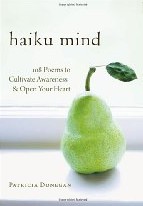The second attribute of the classical
haiku:
Juxtaposition of images.
In one line you have your 'Season Word(s)'.
Put your second image in the other two lines.
|
Consider the energy between your two images.
Try to make them different enough to have some energy between them, a gap that electricity can jump across.
Traditionally Japanese has no punctuation. Often a Japanese haiku connects its images by
a kireji (cutting word).
That's similar to the way in English we say, "dot dot dot"
or "quote".
A haiku in Japanese is written in a single vertical line, with a standard rhythm that provides pauses
after the first and second phrase.
In English, translators have inserted line breaks to signify this pause.
The line break can be enough; or use an em-dash or ellipsis.
Be aware of the energy of the gap between the juxtaposed images.
It can be called "The Goldilocks Gap"
because it should be not too small and not too big;
the large gap allows the reader to leap between the two images without falling in a chasm between them.
Haiku techniques for the images and their relationships
include: Association; Contrast; Comparison; Divine in the common;
Focus narrowing; Paradox; Riddle; Sabi (loneliness, solitude, beauty);
Shasei (nature sketch); Synesthesia (sense switching);
Wabi (beauty of the worn, aged, and simple); Yügen (mystery and sacredness of the ordinary).







